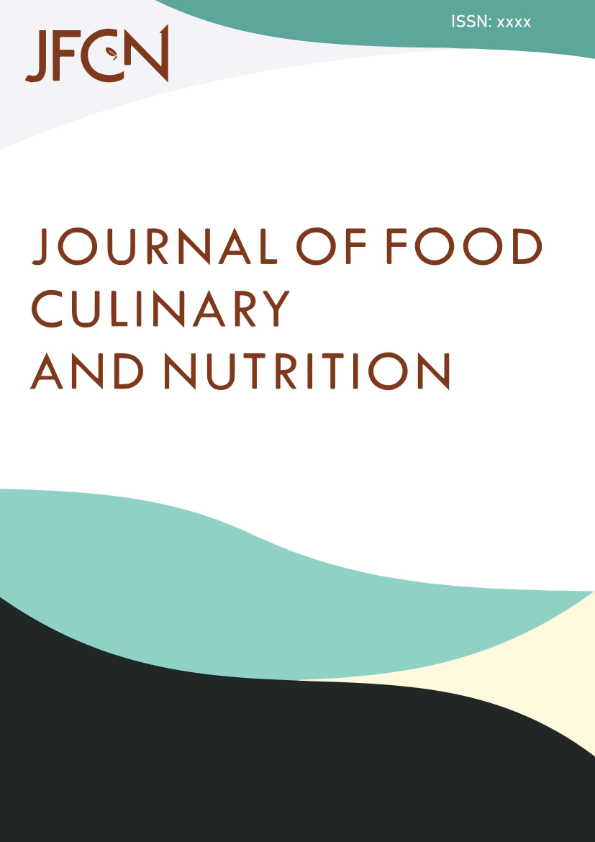Chemical Characteristics Profile of Temulawak (Curcuma xanthorrhiza) Extract Processed Using a Miniplant-Scale Extractor with Variations in Temperature and Time
Abstract
Temulawak (Curcuma zanthorrhiza) is a herbal plant native to Indonesia that contains bioactive compounds, such as curcuminoids, which possess antioxidant and anti-inflammatory properties. This study aims to examine the effect of varying extraction temperatures (70°C, 75°C, and 80°C) and extraction times (10, 20, 30, 40, 50, and 60 minutes) on the antioxidant activity and total phenol content of temulawak extract. The extraction was carried out using the conventional method, and the analysis was performed using the DPPH assay for antioxidant activity and the Folin-Ciocalteu method for total phenol content. The results showed that an extraction temperature of 75°C for 60 minutes yielded the highest antioxidant activity at 63.73%, with a phenol concentration of 63.56 mg GAE/g. At 70°C, antioxidant activity increased from 15.39% at 10 minutes to 60.84% at 60 minutes; however, this temperature was less efficient than 75°C. The extraction at 80°C resulted in the highest pH (7.95) but also increased the risk of bioactive compound degradation, as indicated by the increased variability in antioxidant activity. Overall, an extraction temperature of 75°C with an extraction time of 60 minutes provided optimal results, producing an extract with high antioxidant activity and total phenol content without significant degradation. This study provides valuable insights for optimizing the temulawak extraction process in the health and pharmaceutical industries.
Keywords
Full Text:
PDFReferences
Aisyah, Y., Rasdiansyah, R., & Muhaimin, M. (2014). Pengaruh pemanasan terhadap aktivitas antioksidan pada beberapa jenis sayuran. Jurnal Teknologi dan Industri Pertanian Indonesia, 6(2).
Amelinda, E., Widarta, I. W. R., & Darmayanti, L. P. T. (2018). Pengaruh waktu maserasi terhadap aktivitas antioksidan ekstrak rimpang temulawak (Curcuma xanthorriza Roxb.). Jurnal Ilmu dan Teknologi Pangan, 7(4), 165-174.
Budiati, A., Rahmat, D., & Alwiyah, Z. (2021). Aktivitas Antioksidan dan Tabir Surya Nanopartikel Ekstrak Rimpang Temulawak (Curcuma Xanthorrhiza Roxb.) dan Formulasi dalam Bentuk Krim. Jurnal Jamu Indonesia, 6(2), 75-83.
Cahyono, B., Diah Khoirul Huda, M., & Limantara, L. (2011). Pengaruh proses pengeringan rimpang temulawak (Curcuma xanthorriza roxb) terhadap kandungan dan komposisi kurkuminoid. Reaktor, Vol. 13 No. 3, Juni 2011, Hal. 165-171
Chaaban, H., Ioannou, I., Chebil, L., Slimane, M., Gérardin, C., Paris, C., ... & Ghoul, M. (2017). Effect of heat processing on thermal stability and antioxidant activity of six flavonoids. Journal of food processing and preservation, 41(5), e13203.
Chen, Z., Xia, Y., Liao, S., Huang, Y., Li, Y., He, Y., ... & Li, B. (2014). Thermal degradation kinetics study of curcumin with nonlinear methods. Food chemistry, 155, 81-86.
Dwiseptianti, C., Susanto, F. A., Purwestri, Y. A., & Nuringtyas, T. R. (2019). Optimasi Metode 1H-NMR Profiling pada Rimpang Kunyit (Curcuma domestica). Bioeksperimen: Jurnal Penelitian Biologi, 5(2), 106-113.
Jakubczyk, K., Drużga, A., Katarzyna, J., & Skonieczna-Żydecka, K. (2020). Antioxidant potential of curcumin—A meta-analysis of randomized clinical trials. Antioxidants, 9(11), 1092.
Magdalena, N. V., & Kusnadi, J. (2015). Antibakteri dari Ekstrak Kasar Daun Gambir (Uncaria gambir Var Cubadak) Metode Microwave-Assisted Extraction Terhadap Bakteri Patogen [In Press Januari 2015]. Jurnal Pangan dan Agroindustri, 3(1), 124-135.
Mashita, A. R. (2014). Efek Antimikroba Ekstrak Rimpang Temulawak (Curcuma xanthorrhiza) Terhadap Pertumbuhan Staphylococcus aureus. Saintika Medika, 10(2), 138-144.
Maslukhah, Y. L., Widyaningsih, T. D., Waziiroh, E., Wijayanti, N., & Sriherfyna, F. H. (2016). Faktor pengaruh ekstraksi cincau hitam (Mesona palustris bl) skala pilot plant: kajian pustaka [in press januari 2016]. Jurnal Pangan dan Agroindustri, 4(1).
Nurcholis, W., & Bintang, M. (2017). Perbandingan aktivitas antioksidan dan kandungan fenolik temulawak dan temu ireng. Jurnal Jamu Indonesia, 2(1), 25-29.
Pratiwi, D., & Wardaniati, I. (2019). Pengaruh variasi perlakuan (segar dan simplisia) rimpang kunyit (Curcuma domestica) terhadap aktivitas antioksidan dan kadar fenol total. Jurnal Farmasi Higea, 11(2), 159-165.
Purwanto, A. (2022). Potensi Tumbuhan Obat Unggul Indonesia. Biospektrum Jurnal Biologi, 1(1).
Rosidi, A., Khomsan, A., Setiawan, B., Riyadi, H., & Briawan, D. (2014). Potensi temulawak (Curcuma xanthorrhiza Roxb) sebagai antioksidan. In Prosiding Seminar Nasional & Internasional.
Setyowati, A., & Suryani, C. L. (2013). Peningkatan kadar kurkuminoid dan aktivitas antioksidan minuman instan temulawak dan kunyit. Agritech, 33(4), 363-370.
Shanty, W. Y. (2016). SEMULA (Sirup Temulawak) Olahan Toga untuk Pemberdayaan Masyarakat Desa Kepuharjo, Karangploso Kabupaten Malang. Abdimas: Jurnal Pengabdian Masyarakat Universitas Merdeka Malang, 1(1).
Sholikhah, N. I., Alfian, M., & Fatimah, F. A. (2023). Uji Aktivitas Antioksidan Minuman Serbuk Instan Temulawak (Curcuma Xanthorriza Roxb) Produksi Mitra Sehat Kiringan Bantul. Jurnal Kefarmasian Akfarindo, 50-55.
Simamora, E. F., Zandroto, N. B., Tarigan, P., Sidauruk, V. P., & Suwanto, F. R. (2024). Pemodelan Konveksi Panas Pada Fluida Statis dan Dinamis Dalam Bentuk Persamaan Diferensial Orde 1. Bilangan: Jurnal Ilmiah Matematika, Kebumian dan Angkasa, 2(4), 01-10.
Sundu, R., Supriningrum, R., & Fatimah, N. (2022). Kandungan total senyawa fenol, total senyawa flavonoid dan aktivitas antioksidan ektsrak etanol kulit batang sekilang (Embelia borneensis Scheff.). Bivalen: Chemical Studies Journal, 5(2), 31-36.
Sutarsi, Jati, P. T., Wiradiestia, D., Altway, A., Winardi, S., Wahyudiono, & Machmudah, S. (2023). Extraction Process Optimization of Curcumin from Curcuma xanthorrhiza Roxb. with Supercritical Carbon Dioxide Using Ethanol as a Cosolvent. ACS omega, 9(1), 1251-1264.
Wahyuni, D. T., & Widjanarko, S. B. (2015). Pengaruh Jenis Pelarut Dan Lama Ekstraksi Terhadap Ekstrak Karotenoid Labu Kuning Dengan Metode Gelombang Ultrasonik [In Press April 2014]. Jurnal Pangan dan Agroindustri, 3(2), 390-401.
Wardhani, R. R. A. A. K., Akhyar, O., & Prasiska, E. (2018). Analisis skrining fitokimia, kadar total fenol-flavonoid dan aktivitas antioksidan ekstrak etanol kulit kayu tanaman galam rawa gambut (Melaleuca cajuputi Roxb). Al Ulum: Jurnal Sains Dan Teknologi, 4(1), 39-45.
Yasacaxena, P. L. N., Defi, M. N., Kandari, V. P., Weru, P. T. R., Papilaya, F. E., Oktafera, M., & Setyaningsih, D.(2023) Ekstraksi Rimpang Temulawak (Curcuma xanthorrhiza Roxb.) dan Aktivitas Sebagai Antibakteri. Jurnal Jamu Indonesia 8(1):10-17.
DOI: https://doi.org/10.24167/jfcn.v1i2.13232
DOI (PDF): https://doi.org/10.24167/jfcn.v1i2.13232.g3175
Refbacks
- There are currently no refbacks.
Copyright (c) 2025 Journal of Food, Culinary, and Nutrition
Online ISSN : 3063-4121 JFCN Stats








